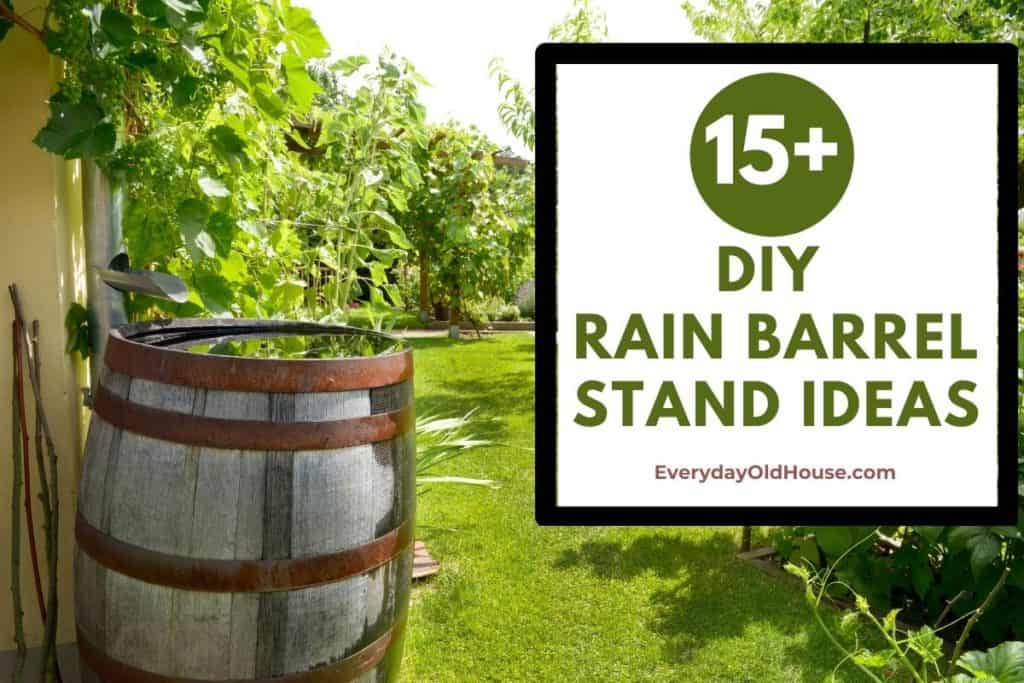Last Updated on March 22, 2024
This spring we pulled out our rain barrels from the garage and installed them under the rain gutters, looking forward to the free water for our gardens. But only 3 weeks into gardening season, I had to ask myself – why does my rain barrel smell SO bad? After scouring the internet, I found the reasons why my rain barrel smells (with 10 ways to fix it).
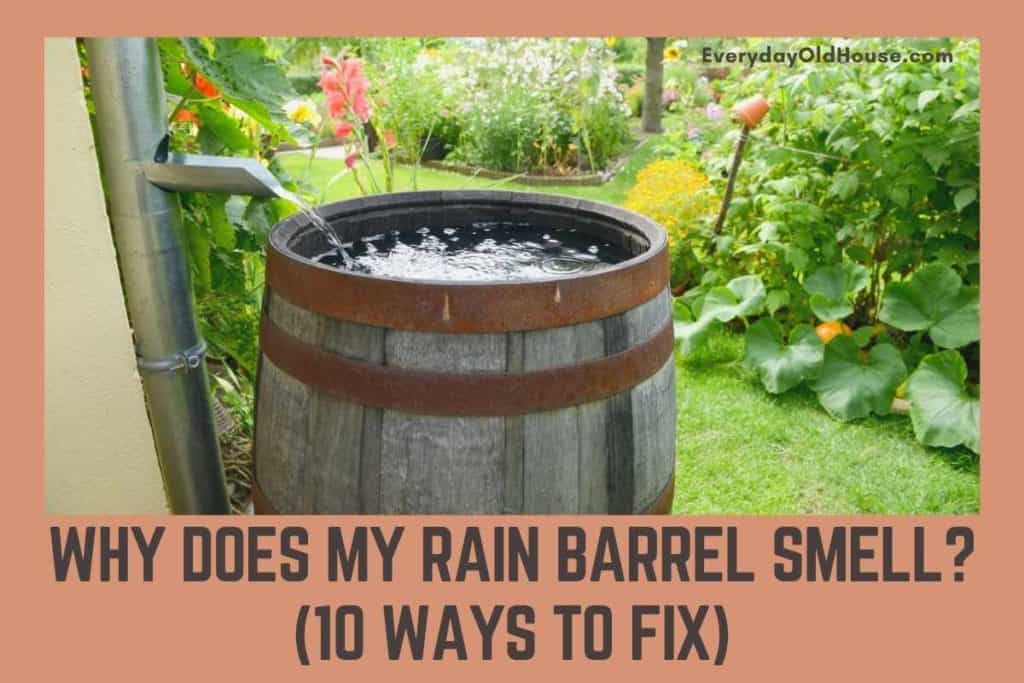
This post contains affiliate links, including but not limited to, Amazon Associates. As such, I earn from qualifying purchases. Full disclosure located here.
The Rain Barrel Smell
The water in my rain barrel smelled like a pile of sweaty basketball socks that had been marinating for months. Not kidding. It was noxious and atrocious.
While I don’t mind (and expect) a slight smell from my rain barrel, this was completely overwhelming. I couldn’t stomach it. I couldn’t imagine using this offensive, funky water on my vegetable garden and actually eating its harvest. Quick frankly, the smell made me gag.
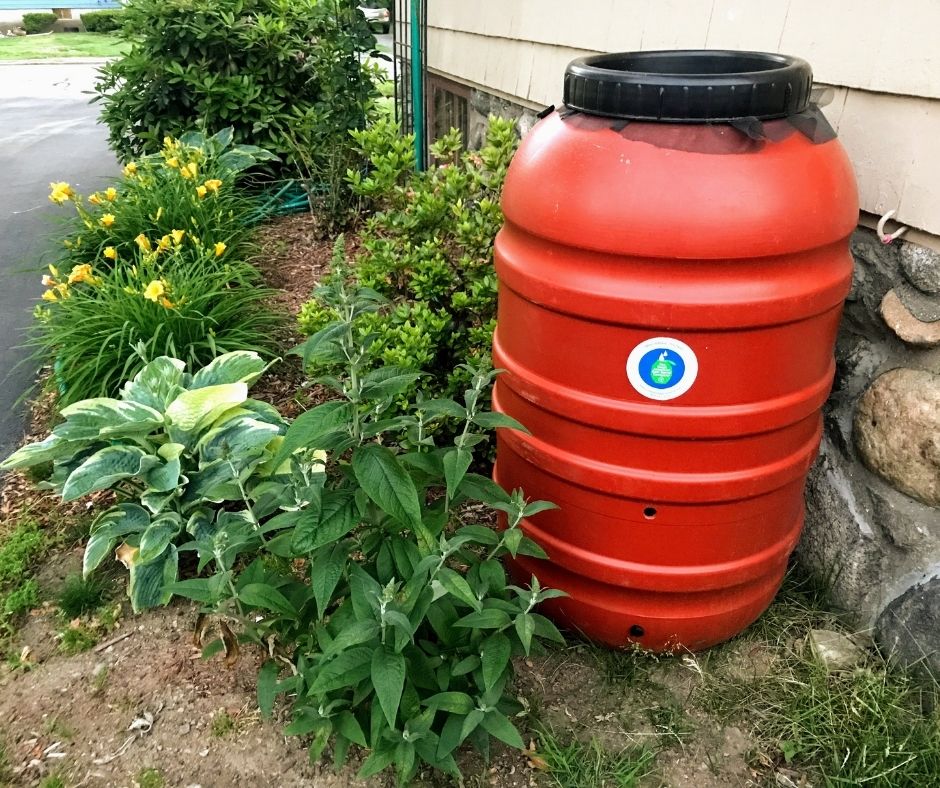
So, why the heck does my rain barrel smell? What is causing it, and how do I get rid of it? To the internet I go…..
Why Your Rain Barrel Smells
Unfortunately you have just experienced of the disadvantages of rain barrels. The best way to diagnose the funky smell in your rain barrel is to first understand how a rain barrel works.
The process of rainwater collection is quite simple. Rainwater hits your roof and then travels down through your gutters to the downspout and into your rain barrel. Simple, right?
Here’s where it gets “fun”. On its journey from the roofline to rain barrel, the rainwater collects leaves, pine needles, twigs, algae, debris, sediment, pollen, bird droppings, bacteria, etc… Yuck.
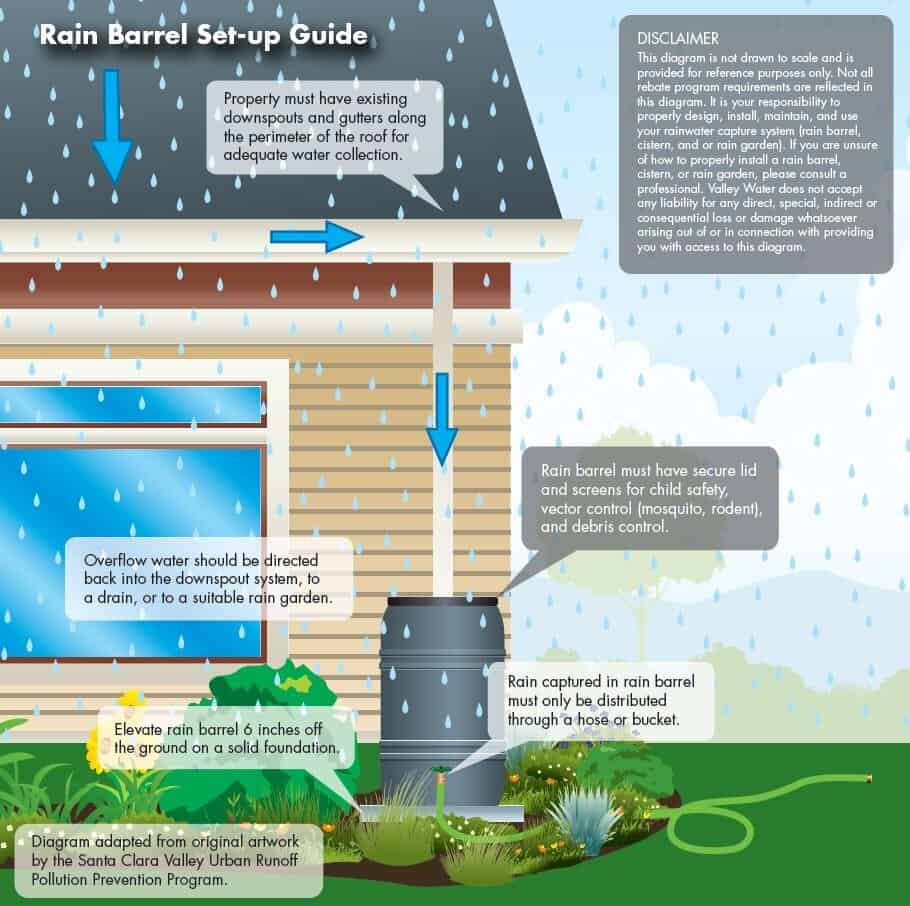
Luckily, most rain barrels have screens that filter out the larger particles (and mosquitos). But a good portion of whatever was swooped up by rainwater will wind up in your rain barrel.
The good news is that if you use that rainwater within a short period (ex: within a month) it’s usually not a problem (except for pollen, I’ll explain later).
But if the water stays stagnant for too long, that’s when you may start wondering why your rain barrel smells. After a while, the leaves, pine needles, pollen, etc.. collected by the rainwater through your gutters starts decay. Algae thrives, causing algal blooms. Bacteria join the party and feed on that organic goo, producing that strong, putrid smell in your rain barrel.
Usually this creates a sulfur, rotten egg type smell. But sometimes (in our case) the funky smell is stinky socks. Which apparently is specific to the smell of fermenting pollen. In the springtime, this situation is not uncommon with a heavy pollen season combined with short rain showers.
And that was exactly the case for us this spring.
Good News – Rain Barrel Water Doesn’t Go Bad….
The good news is that while your rain barrel smells, it doesn’t mean that the foul water is “bad”. You can still use rainwater as expected – to water lawns, houseplants and gardens. (I assume you know that water collected in rain barrels is NOT potable. You should NEVER drink from rain barrels).
Note that vegetable plants (especially leafy greens) should be watered around the base and not the plant itself. The soil and microorganisms living in the soil will work its purifying magic on your stinky rainwater before it is taken up by your veggie plants.
BUT you don’t have to live with a rain barrel that smells. Luckily there are several simple and inexpensive ways to clear up the air and fix a stinky rain barrel.
9 Ways to Fix Rain Barrel Smells
There’s a variety of ways to clear up and remove a rain barrel smell. Most are free, some cost a few dollars. None take up a lot of time. Now, without further ado…..
1. Use It Up!
Rain barrels are not meant for long-term water storage. I completely understand the feeling of holding onto your rain barrel water for that summer dry spell.
As we learned above, stagnant water produces that marinating “organic goo” that will lead you to wonder – why does my rain barrel smell?
So don’t hoard it, use it up! But water with some care. For example, water any edible plants around the base directly to soil. Do not water any edible vegetables, fruits or herbs directly.
Then, plan your strategy to continually use up the water in your rain barrel on your lawns and garden. Don’t keep a full rain barrel for more than a few weeks or month.
2. Add Bleach
Many experts recommend that every year (usually as part of your regular fall maintenance) to clean out rain barrels with a bleach solution. This same strategy can be also used to deal with smelly rain barrel water sitting in your rain barrels.
To help sanitize dirty water, the Center for Disease Control recommends adding about 1/8th of a teaspoon of 5-9% unscented household bleach to every 1 gallon of water. However, if the water is cloudy, it’s acceptable to increase the amount of bleach to ¼ teaspoon per gallon of water.
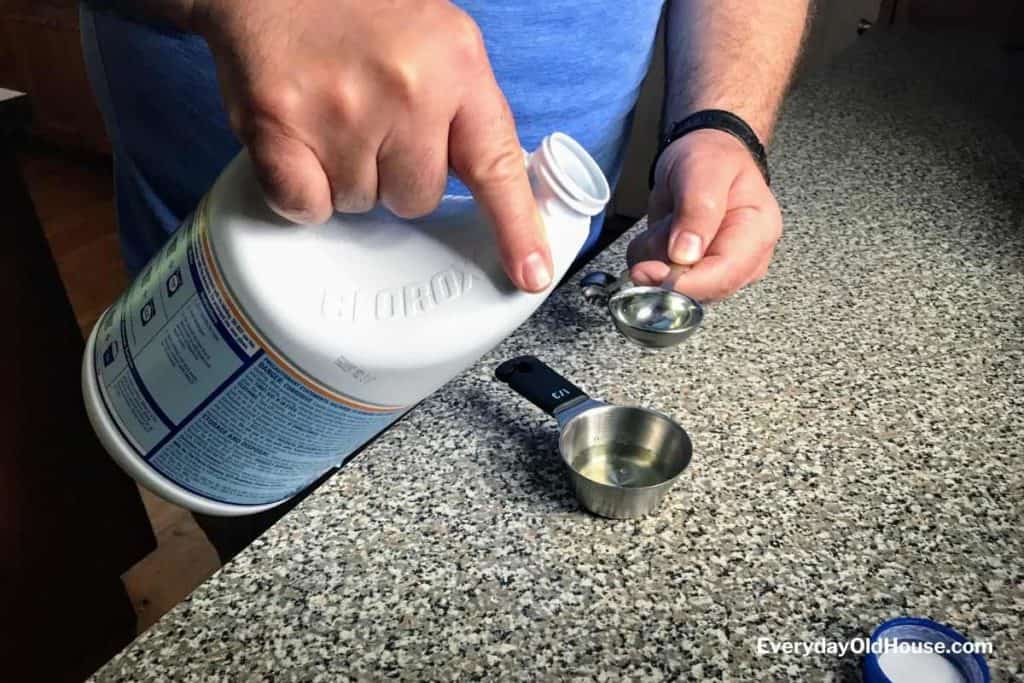
Most residential rain barrels have 40 to 65 gallons of storage capacity, with 55-gallon being standard. If you have a 55-gallon drum like ours, that equates to about 2-5 tablespoons of bleach. It doesn’t seem like a lot, but it will go a long way to removing that rain barrel smell.
After adding bleach, wait about 24 hours before using the water on your plants to allow the bleach to dissipate.
This is the method we chose to use (we added 5 tablespoons), and it worked to remove that stinky sock smell!
3. Store Rain Barrel in Shade
Algae thrives in sunlight. So why not minimize the sunlight? When identifying the best place to install your rain barrel, look for an area that gets the most amount of shade in the summer.
While this method won’t completely remove algae from your water barrels, placing your barrels in indirect sunlight it will curb algae growth. Less algae means cleaner water and reducing the risk of clogging rain barrel components.
You can also consider an area with space to plant large, bushy plants (like hostas) to cover and provide extra shade. Just be careful these plants don’t get too big you can get to the rain barrel spigot!!
If you have a white or clear plastic rain barrel, consider painting it to prevent sunlight from entering. For those who have artistic skill (I do not…), you can turn your rain barrel into an eye-catching garden feature like these.
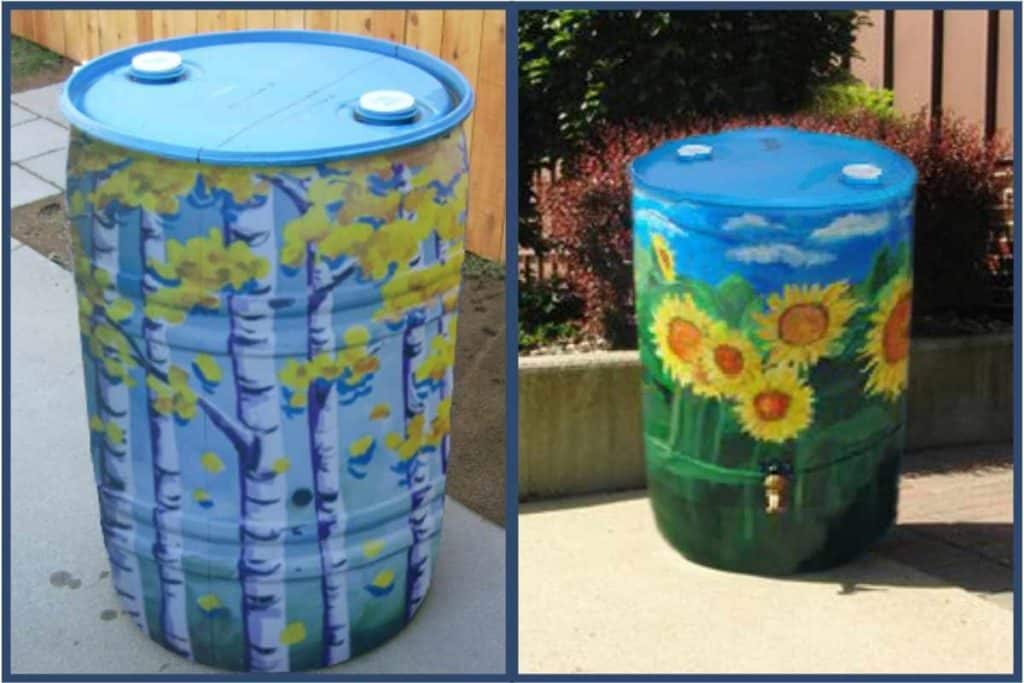
4. Clean Gutters
Cleaning gutters is commonly viewed as a fall maintenance task. But if you clean your gutters also in the springtime before setting up your rain barrel, you pre-emptively remove twigs, leaves, bird droppings, etc… that contribute to a smelly rain barrel in the summer season.
If your gutters tend to get clogged or easily cluttered, you might consider installing gutter guards and screens to stop leaves and debris from landing in gutters in the first place. And clean gutters mean a higher likelihood of cleaner rainwater in your barrels.
5. Connect a First Flush Diverter
The first water that falls from a rainstorm usually is the dirtiest. It tends to collect the bulk of debris, bird droppings, etc that have accumulated on the roof and in your gutters. This is especially the case for rainstorms after a dry spell.
To avoid collecting this dirty rainwater in your barrel, many commercially available rain barrel systems come with a first-flush diverter (also known as a roof washer). This captures the first water and diverts it from entering the rain barrel. Instead, it sends this dirty water direct to the ground or a storm drain.
If your rain barrel has an installed first flush diverter, check it to make sure it’s not clogged or damaged and don’t need a new one.
6. Close It Up
This strategy is for folks who have rain barrels with no lids or large openings. These types of rain barrels only work well for short-term collection of rainwater. Rain barrels without lids and screen are a welcome mat for dirty water. Organic debris will accumulate faster than rain barrels that are properly sealed. Small animals like squirrels, frogs, chipmunks can fall in and unintentionally drown (and that can’t be fun to clean up….).
If you plan to collect rainwater on a regular basis, it might be time to buy a lid with a screen or invest in sealed barrel system. For example, we purchased our plastic barrel system at a discount through our town. (Our barrel was food-grade. It smelled like salad dressing when we bought it.)
7. Clean Screen
If you have a more formal rain barrel system with a lid and a screen, it might be time to clean the screen or even buy a new one if you find rips or tears.
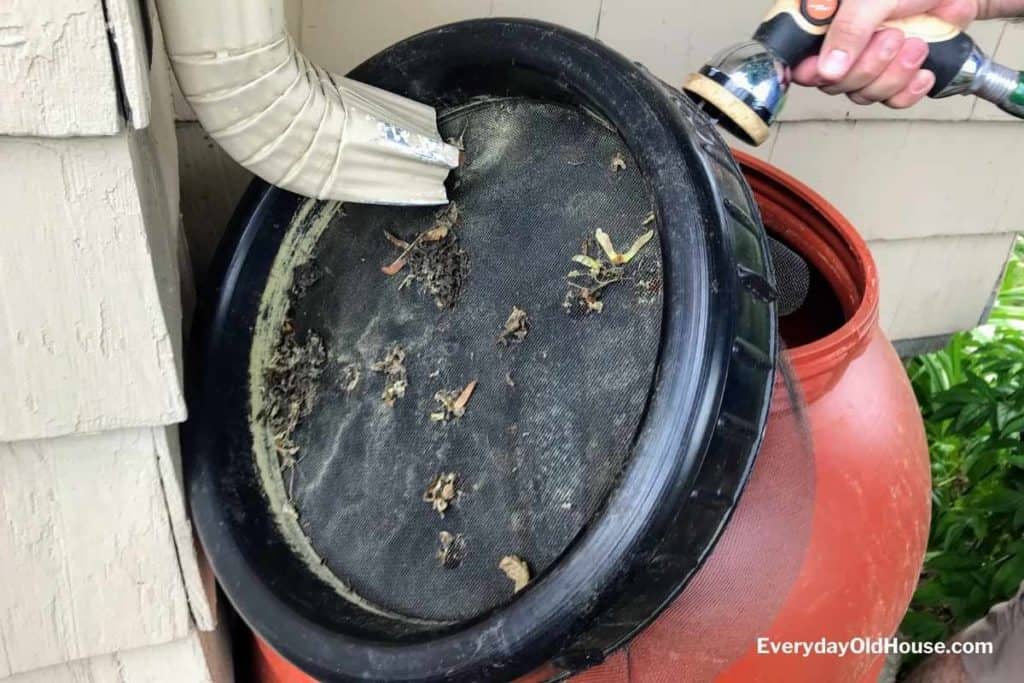
Those screens do a lot of heavy lifting when it comes to filtering out debris collected by rainwater flowing through gutters. Cleaning or replacing your screen is a powerful yet simple way to stop the gunk from getting into your rain barrels. For added screen protection, consider installing a filter on your gutter downspout.
8. Clean It Out
Another method to stop rain barrel smells is to start from scratch. Drain out the putrid water, clean the barrel and start again.
Personally, I think this remedy sound counterproductive and should be used as a last resort? It doesn’t make sense to go through the trouble of collecting rainwater only to toss it.
But if you go this method, consider cleaning using this formula from The Rain Barrel Man (2 tsp. of Hydrogen Peroxide, 2 tsp. of vinegar, and 2 tsp. of Dawn detergent per gallon of water).
9. Commercial Algae Killer
I found this intriguing solution to the “Why does my rain barrel smell?” question in a garden community chat room. Here’s the thought process….
Commercial algae killers are used by homeowners to clarify backyard water features, including water lily ponds and those gorgeous koi ponds. If not well-maintained, they can easily become victims of algae blooms.
If these commercial algae killers can solve the algae problems in water features, AND are safe enough for fish, plants, and wildlife, shouldn’t they also stop algae growth in smelly rain barrels?
Since I haven’t tried this, I don’t feel comfortable recommending any products, so I’ll just point you to this informative post.
Since these are chemicals, be sure you are comfortable with correctly dosing your rain barrel. Improper usage could impact your plants. For added level of security, be sure to water around plants (especially leafy greens). And as always, wash all produce before eating.
10. Mint
This last strategy to tackle a smelly rain barrel is fascinating since I love the smell of mint. Captain Patio adds live mint plants inside his barrel and “waits for nature to do its magic”. He adds that mint plants root almost anywhere, so why not in a stinky rain barrel? Hmm….
Related Posts
Want to be the first to know about new posts? Be sure to follow me on Pinterest, Facebook, Instagram or Twitter of even Etsy! Or better yet… Subscribe below!
My monthly (admittedly sometimes more, sometimes less….) emails are like receiving a unexpected letter from an old friend WITHOUT needing to put on your slippers and walk out to your mailbox…. See? I got ya, my friend!)
[Note: My posts are proudly connected to these amazing link parties full of DIY ideas and inspiration!]





